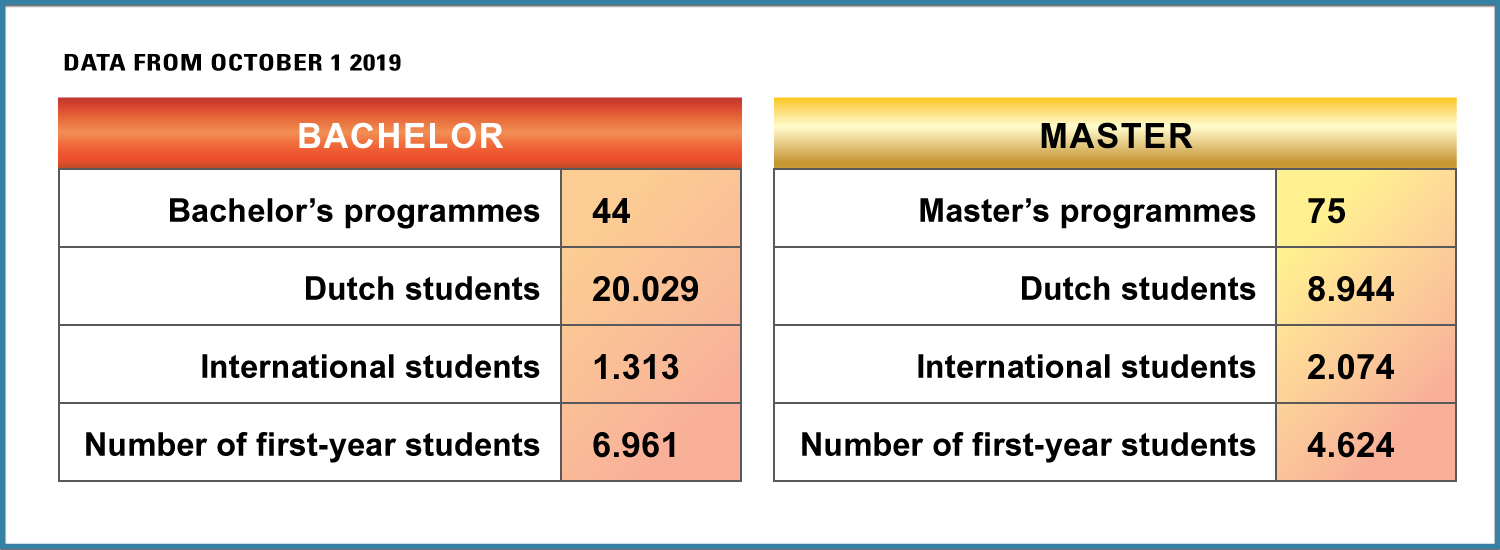Windfalls keep UU’s piggy bank overflowing

Each year around this time, the University Council discusses the UU’s annual financial statements. The financial statements that are being discussed now mention, among other things, the amount of money the university received in 2019, as well as how much it has spent. The trick is to create a budget one year before then that’s zero sum: the cash flow to the university is equal to its expenditures. But because the university has a lot of money in reserves, the decision was made in 2018 to spend 31.3 million euros more than it would receive. It has failed to do so this year. The financial statement shows ‘only’ a minus of 300,000 euros. How’s that possible?
The UU does have a lot of money in its reserves. This is due to previous years and years of surpluses. These surpluses were allocated to education and research and were meant to be spent on these causes, albeit with some delay. But cutbacks from the government and disappointing results from the past turned several faculties and departments, which had dealt with cutbacks before, into careful spenders.
By the time money was once more allowed to flow, this only happened sparingly, as the financially meagre years were still fresh in everyone’s memory. It wasn’t just the faculties and departments that budgeted carefully; the university itself did the same, making the reserves grow. Add to that the last couple of years, in which the university had some financial windfalls after summer holidays, some of which came from The Hague. Lastly, sometimes it proved impossible to recruit sufficient, qualified employees.
Money had to roll
Therefore, the money would have to roll in 2019, because large reserves could lead to the Ministry of Education to suspect that the university is rich, and could do well with fewer subsides. The university wanted to prevent this. For that reason, the decision was made in 2018 that more money would be invested on small-scale intensive education, and on combatting workloads. That has indeed happened to a large extent. The number of jobs has grown with 181 fulltime unites (FTEs), excluding the Faculty of Medicine. But the money that was reserved for IT hasn’t been fully spent, because they were unable to find enough qualified employees. That means that some of the money that had been reserved for personnel costs hasn’t been spent yet. Another 3 million euros that was to be spent on policy measures is also still on the shelf. On the other hand, an additional 7 million euros has been spent by Corporate Real Estate & Campus and the Facilities Service Centre, on things like maintenance and depreciation.
However, the windfalls are greater. The faculty of Science, for instance, found an additional 10 million euros after cleaning up its finances from various externally financed research projects. The university has also received more in tuition fees than it had expected – especially from students outside of the EU who pay the institutional tuition fees. Moreover, the Faculty of Law, Economics and Governance and the Faculty of Science received funding from the government in the final quarter for the so-called sector plan funding. The Faculty of Law received 0.6 million euros; Science received 3.2 million euros. Only 0.3 million euros of this fund has been spent so far. Another 2 million euros came from the incentive scheme of European Research, and the Corporate Office, libraries and the Animal Laboratory have spent 6 million euros less than had been budgeted.
Ministry of Education won’t be pleased
The university’s committee of finances is critical about this positive result in 2019. Council member Gert Folkers: “The goal was to spend 30 million of our reserves, and now, we see that we’ve basically spent none at all. That means the university has some explaining to do. The Ministry of Education won’t be pleased. Shouldn’t we run an even tighter ship, for instance by allocating more funding to the faculties so they can relieve workload pressure?”
President Anton Pijpers is also slightly worried about the ministry, but also says the budget for 2020 is already much stricter. The budget includes allocations of funding of which the university isn’t yet sure it will actually receive. At the end of this year, 26.5 million of the university’s reserves should have been spent.
The financial manager of the UU, Michel de Bekker, explains to the committee members that the positive results are incidental, and that there’s no guarantee that similar windfalls will come their way in 2020. He even gives a warning: “We can’t yet estimate what the results of the corona crisis will be in the long term. Perhaps the inflow of students will disappoint, our operations will be more expensive, and we’ll have to deal with delays in research. We can’t just break loose in 2020.” Moreover, the financial estimates for the coming years state that 60 million of the university’s reserves will be spent before 2022.
IT can/cannot find staff
Utrecht University has been investing many millions in the IT Department for years, for IT innovation in education and research, among other things. And now that everyone’s working from home and all education takes place online, the whole university is benefiting from those investments. The Finances committee of the University Council acknowledges this, too. Still, University Council member Wim de Smidt would like to know what the cause is of the surpluses the IT Department has had for the past three years because it can’t seem to hire the right people. “Shouldn’t we speed up recruitment for those vacancies?” President Anton Pijpers says the UU isn’t the only place looking for qualified IT staff. “We do have enough new people coming in, but many others are leaving as well. There’s a big market for IT staff right now.” Soon, he says, there’ll be a plan for recruiting and keeping IT staff.
Staff, permanent and temporary
60 percent of the total budget is spent on personnel. The total cost of staff amounts to a little over 600 million euros, of which nearly 574 is comprised of salary costs. In bookkeeping, personnel is always counted in fulltime units (FTE) instead of numbers of employees. In 2019 the number of FTE increased by 181 FTE. Of these, 117 FTE are scientific staff, and 64 percent are support staff. This increase is mostly due to the university hiring more teachers so it could offer small-scale, intensive education.
The UU is trying its best to turn as many temporary contracts into permanent or four-year contracts as possible. It had agreed with the unions that no more than 22 percent was to have a temporary contract. After the summer, there was a small spike in this percentage as many new temporary teachers were hired then. At the end of 2019, 22.4 percent of the Utrecht University employees had a temporary contract.
Student numbers
In 2019, Utrecht University had 32,360 students. That’s less than in 2018, despite a small increase in national student numbers. The Dutch universities had a combined total of 303,299 students in 2019.
The number of international students has increased compared to 2018: 11.7 percent nationally, 14.6 percent at the UU. Of all the students in 2019, 10.5 percent are international. This means the UU has reached its goal of growing to a student constituency with 10 percent of international students, as it had stated in its previous Strategic Plan. Numerous English-spoken programmes turned out to be highly attractive to students from outside the Netherlands, according to rector Henk Kummeling in the committee of Education, Research, and Students. The rector does not expect this increase to continue. At the moment, the number of applications is similar to last year’s, although it remains uncertain how many applications will actually turn into registrations.
